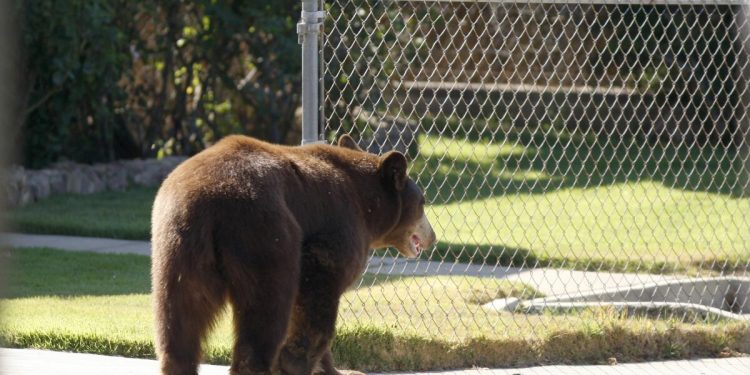California’s black bears are intelligent, ingenious and opportunistic. They eat everything and anything – fruit, nuts, insects, human food and pet food. They like bird feeders. They brave the killings of the mountain lion – like the deer – they find. This is called kleptoparasitism. They can use their lower teeth to open a unlocked car door. If they find a path in your home and your kitchen, they can open pots of peanut butter and jam and, of course, honey.
They are the only species of state bear and, despite their name, their ranges of furs are in color from blond to black. It has been a century that the Grizzly Bear was driven out of extinction in California, leaving only its image ironically, on the state flag.
The estimation of black bears is a difficult exercise. In its black bear conservation plan, California estimates Department of Fish and Wildlife – using a new methodology – the population at around 65,000 and says it has been stable for a decade. (For years, the Department had estimated the population at 35,000 people using less advanced statistical modeling.) The Wendy Keefover fauna strategist from the Humane World for Animals group – formerly the Human Society of the United States – maintains that the number is simply a supposition, and it plans to replace too much development.
Anyway with the bear population, we know with certainty that wears-human interaction reports have increased. According to the Ministry of Fish and Wildlife, reports have been increasing for decades – not because of more bear but more people living and on vacation in territory in bears. There were an average of 674 reports per year from 2017 to 2020, but that climbed up to 1,678 per year in 2021 and 2022. The Lake Tahoe basin and the foothills of the San Gabriel mountains were special hot spots.
The Californian Heather Hadwick (R -Alturas), whose district includes one of these hot spots, introduced Bill 1038 of the Assembly, which would allow hunters to muddy the bears – but do not kill them – by making dogs pursuing them. Hunting bears by hunters during the bear hunting season was prohibited by the Legislative Assembly in 2012 and should not return even if hunters do not intend to kill the bears.
As in 2012, he remains cruel towards bears, who end up exhausting and clinging to a tree. Dogs and bears can fight. And we do not know how to hunt a random bear, perhaps in a forest, will discourage him from the search for food for humans. (The Ministry of Fish and Wildlife already allows, in limited situations, in particular the problem bears in communities or near the cattle to be bizarre by dogs.)
Another part of the Hadwick bill would authorize the fish and game commission to decide if hunters could use dogs again to hunt and kill bears. The legislator has already prohibited this practice and abandon its power on this prohibition to a designated commission has no meaning.
Although the proposals of this bill are not useful, meetings by humans are dangerous and must be minimized. There is a better way to do it. The department and the defenders of animal welfare strongly urge Californians to find ways to make houses, cars, campsites and unattractive farms in the bears. There are many suggestions. Bear love smelly food. Do not leave food outside. Use trash cans with anti-orns locks. Take out all the foods from your car, then lock the car doors. On the door steps, place carpets that cause a slight electric shock when a bear walks on it; They are called “unwanted carpets”. Sanitary voids under the bridges must be secure. Remove the bird feeders from your courtyard.
Livestock should be kept in secure pens at night. Electric fences can be installed around chicken chickens and boxes. And for bears that continue to spy on houses or livestock, there are means of hazing that do not involve dogs pursuing them. The lights activated by movement, noise manufacturers and alarms can scare carriers.
And don’t nourish them. In fact, it is prohibited in the state of California. But Ann Bryant, executive director and founder of the Bear League in the Tahoe basin, says that some vacationers do it anyway, putting food outside wherever they remain in the hope of attracting a bear and then taking a photo. It works – then the bear returns while waiting for more food. It is at this point that Bryant, whose organizations of the organization help people live more harmoniously with the bears, receives a call from someone who wants to know how to make the bear stop.
Bryant’s advice is simple and simple: stop putting food off, and if the bear reproduces, “you trample your feet and cry:” Go out here! ” You remove his confidence that people will be nice and feed them. You have to make the bear known that the party is over.
So, with all these methods, why do bears continue to come? “These methods work,” said the spokesperson for Fish and Wildlife, Peter Tira. They just need to be more widely adopted: “The key is education and continuous conscience, forming good habits, reaching residents and visitors to the country.”
It will be up to the department to more aggressively pass the message. But here are some tips that tourists should remember, says Bryant: “Always think in the bottom of your mind:” I am in the bear country. “”
California Daily Newspapers


